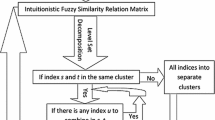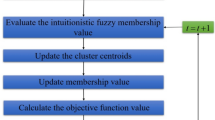Abstract
For observations to be classified, when scoring rules are imprecise or the cost of their computation is too high, the clustering method under linguistic information is necessary. Considering the accuracy of intuitionistic fuzzy linguistic variable in expressing experts’ opinions, a clustering algorithm is presented in this paper. Firstly, the concept of triangular intuitionistic fuzzy linguistic variables (TIFLVs) is introduced, and a new formula is developed for calculating correlation coefficient of TIFLVs. Then, the correlation coefficient plays a central role in our modified λ-cutting algorithm for clustering, which is utilized to construct an equivalence correlation matrix. In addition, a silhouette cluster validity index of TIFLVs is proposed to revise the results of clustering. Finally, the experimental results demonstrate the application and practicability of the clustering algorithm.


Similar content being viewed by others
References
Zadeh LA (1965) Fuzzy sets. Inf Control 8:338–353
Zadeh LA (1975) The concept of a linguistic variable and its applications to approximate reasoning—part I. Inf Sci 8:199–249
Zadeh LA (1975) The concept of a linguistic variable and its applications to approximate reasoning—part II. Inf Sci 8:301–357
Zadeh LA (1975) The concept of a linguistic variable and its applications to approximate reasoning—part III. Inf Sci 9:43–80
Zadeh LA (1973) Outline of a new approach to the analysis of complex systems and decision processes. IEEE Trans Syst Man Cybern 1:28–44
Atanassov K (1986) Intuitionistic fuzzy sets. Fuzzy Sets Syst 20:87–96
Halkidi M, Batistakis Y, Vazirgiannis M (2001) On clustering validation techniques. J Intell Inf Syst 17(2):107–145
Bellman R, Kalaba R, Zadeh L (1966) Abstraction and pattern classification. J Math Anal Appl 13(1):1–7
Macqueen J (1967) Some methods for classification and analysis of multivariate observations. In: Proceedings of the fifth Berkeley symposium on mathematical statistics and probability, California, USA, vol 1, no 14, pp 281–297
Gasch AP, Eisen MB (2002) Exploring the conditional coregulation of yeast gene expression through fuzzy k-means clustering. Genome Biol 3(11):1–22
Li MJ, Ng MK, Cheung YM, Huang JZ (2008) Agglomerative fuzzy k-means clustering algorithm with selection of number of clusters. IEEE Trans Knowl Data Eng 20(11):1519–1534
Burrough PA, van Gaans PFM, MacMillan RA (2000) High-resolution landform classification using fuzzy k-means. Fuzzy Sets Syst 113(1):37–52
Li D, Deogun J, Spaulding W, Shuart B (2004) Towards missing data imputation: a study of fuzzy k-means clustering method rough sets and current trends in computing. Springer, Berlin, pp 573–579
Bezdek JC, Ehrlich R, Full W (1984) FCM: the fuzzy c-means clustering algorithm. Comput Geosci 10(2):191–203
Dunn JC (1974) Well-separated clusters and optimal fuzzy partitions. J Cybern 4(1):95–104
Gong MG, Liang Y, Shi J, Ma WeP, Ma JJ (2013) Fuzzy c-means clustering with local information and kernel metric for image segmentation. IEEE Trans Image Process 22(2):573–584
Izakian H, Abraham A (2011) Fuzzy C-means and fuzzy swarm for fuzzy clustering problem. Expert Syst Appl 38(3):1835–1838
Krinidis S, Chatzis V (2010) A robust fuzzy local information C-means clustering algorithm. IEEE Trans Image Process 19(5):1328–1337
Pal NR, Pal K, Keller JM, Bezdek JC (2005) A possibilistic fuzzy c-means clustering algorithm. IEEE Trans Fuzzy Syst 13(4):517–530
Wang PZ (1983) Fuzzy set theory and applications. Shanghai Scientific and Technical Publishers, Shanghai
Xu ZS (2006) On correlation measures of intuitionistic fuzzy sets. Lect Notes Comput Sci 4224:16–24
Mitchell HB (2004) A correlation coefficient for intuitionistic fuzzy sets. Int J Intell Syst 19:483–490
Hung WL, Wu JW (2002) Correlation of intuitionistic fuzzy sets by centroid method. Inf Sci 144:219–225
Xu ZS, Chen J, Wu JJ (2008) Clustering algorithm for intuitionistic fuzzy sets. Inf Sci 178(19):3775–3790
Le HS, Cuong BC, Lanzi PL et al (2012) A novel intuitionistic fuzzy clustering method for geo-demographic analysis. Expert Syst Appl 39(10):9848–9859
Xian SD, Xue WT, Zhang JF, Yin YB, Xie Q (2015) Intuitionistic fuzzy linguistic induced ordered weighted averaging operator for group decision making. Int J Uncertain Fuzziness Knowl Based Syst 23(4):627–648
Xian SD, Sun WJ,Xu SH,Gao YY(2016) Fuzzy linguistic induced OWA Minkowski distance operator and its application in group decision making. Pattern Anal Appl 9(2):325–335
Zhang HM, Xu ZS, Chen Q (2007) On clustering approach to intuitionistic fuzzy sets. Control Decis 22(8):882–888
Xu ZS, Yager RR (2006) Some geometric aggregation operators based intuitionistic fuzzy sets. Int J Gen Syst 35(4):417–433
Yager RR, Filev DP (1998) Operations for granular computing: mixing words and numbers. In: Proceedings of the fuzzy-IEEE world congress on computational intelligence, Anchorage, pp 123–128
Xian SD (2012) Fuzzy linguistic induce order weighted averaging operator and its application. J Appl Math. https://doi.org/10.1155/2012/210392
Xian SD, Sun WJ (2014) Fuzzy linguistic induced euclidean OWA distance operator and its application in group linguistic decision making. Int J Intell Syst 29(5):478–491
Herrera F, Herrera-Viedma E (2000) Linguistic decision analysis: steps for solving decision problems under linguistic information. Fuzzy Sets Syst 115:67–82
MartíNez L, Herrera F (2012) An overview on the 2-tuple linguistic model for computing with words in decision making: extensions, applications and challenges. Inf Sci 207:1–18
Li DF, Nan JX, Zhang MJ (2010) A ranking method of triangular intuitionistic fuzzy numbers and application to decision making. Int J Comput Intell Syst 3(5):522–530
Herrera F, Herrera-Viedma E, Verdegay JL (1996) Direct approach processes in group decision making using linguistic OWA operators. Fuzzy Sets Syst 79(2):175–190
Herrera F, Herrera-Viedma E (1997) Aggregation operators for linguistic weighted information. IEEE Trans Syst Man Cybern Part A Syst Hum 27(5):646–656
Xu ZS (2007) Intuitionistic fuzzy aggregation operators. IEEE Trans Fuzzy Syst 15:1179–1187
Xian SD, Jing N, Xue WT et al (2017) A new intuitionistic fuzzy linguistic hybrid aggregation operator and its application for linguistic group decision making. Int J Intell Syst 32(12):1332–1352
Xu ZS (2007) Group decision making with triangular fuzzy linguistic variables. Lect Notes Comput Sci 4881:17–26
Xu ZS (2004) Uncertain linguistic aggregation operators based approach to multiple attribute group decision making under uncertain linguistic environment. Inf Sci 168:178–184
Amorim RCD, Hennig C (2015) Recovering the number of clusters in data sets with noise features using feature rescaling factors. Inf Sci 324:126–145
Amorim RCD, Hennig C (1987) Silhouettes: a graphical aid to the interpretation and validation of cluster analysis. Comput Appl Math 20:53–65
Acknowledgements
This work was supported by the Chongqing research and innovation project of graduate students (Nos. CYS17227, CYS18252), the Graduate Teaching Reform Research Program of Chongqing Municipal Education Commission (Nos. YJG183074).
Author information
Authors and Affiliations
Corresponding author
Rights and permissions
About this article
Cite this article
Xian, S., Yin, Y., Liu, Y. et al. Intuitionistic fuzzy linguistic clustering algorithm based on a new correlation coefficient for intuitionistic fuzzy linguistic information. Pattern Anal Applic 22, 907–918 (2019). https://doi.org/10.1007/s10044-018-0744-x
Received:
Accepted:
Published:
Issue Date:
DOI: https://doi.org/10.1007/s10044-018-0744-x




